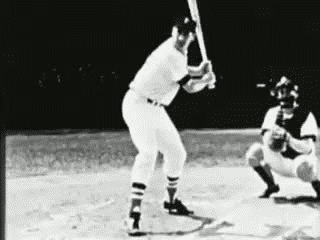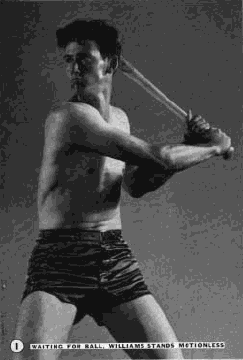Belated Farewell to a Real Legend of “Game”
Ted Williams passed -away on July 5th, 2002, but the memory of this “Legend” will not die!
To be a great hitter in Major League baseball, it doesn’t hurt to have the visual acuity of one in 200,000 people. It is purported that Ted Williams had that kind visual advantage over his colleagues. Legend would have it that Ted saw the ball coming before it left the umpire’s pouch.
But if he had the greatest eyesight in the world, and didn’t put much thought behind the action of his swing, he would have been a “decent hitter” at best. Unlike Babe Ruth, Mickey Mantle, and scores of other legendary ballplayers, Ted Williams didn’t just take his natural talent into the batter’s box and proceed to bash away at every “good-enough” pitch his bat could reach. He let his thought about the science of hitting a baseball precede his footsteps into that rarefied cubicle of variable distinction.
Ted Williams said it best for all of us who have ever played the game of Baseball as well as participated in other forms of athletics, “hitting a baseball is the single-most difficult thing to do in all of sports.” No other individual sport-skill encompasses the variety of challenging variables that a batter has to quickly “put in order” to be a proficient “hitter.”
It takes physical strength, flexibility, quickness, and timing as well as the mental attributes of courage, confidence, determination, and fortitude for even the least skilled professional to “stand-in” against a 95mph fastball, or 85+ slider. When you add in all the off-speed multiples, you wonder why the Defense Department doesn’t make “Batting 444″ a pre-requisite for the highest combat-training courses. (No wonder Ted was successful in the military)
The “best hitter” is not merely one who makes solid contact with the ball. But rather, he is a batter whose body mechanics facilitate the action of the swinging bat to contact the ball at an angle that provides for a straight (non-hooking or slicing) and ascending “line-drive.” The “Art” of hitting a baseball certainly could be defined in the context of describing the ideal hitter– “He is one whose bat most consistently contacts the ball in a manner that facilitates a straight and ascending “line-drive.”
Ted Williams was probably the epitome of the “Ideal-Hitter.” I don’t think that he was ever in a “slump” because he always knew what he had to do, or was supposed to, and what his body was actually doing, to hit the ball properly (or improperly). He approached “hitting” from a scientific standpoint. Therefore, it wasn’t so much how he felt at the plate. It was how well he was following his understood principle that determined the outcome of his stroke, in most of his batting situations.
To watch Ted at the plate one would become aware of the fact that the act of hitting a baseball efficiently is both an “Art” and a “Science.” Those who demonstrate a high degree of talent in any of the various art forms could easily be described as “artists.” There is adequate evidence to indicate that many or most good artists (of which athletes are included) have a “natural” propensity toward the artisanship in which they are engaged.
But their optimal level of proficiency is most often derived from the degree to which they accumulate enhanced understanding by means of scientific examination of all aspects of their chosen profession. (Leonardo da Vinci comes to mind.)Therefore, hitting a baseball most effectively would have to be construed as both an Art and a Science. And that is why it would be easy to remember this “Master of the Bat” for his scientific artistry in hitting a baseball.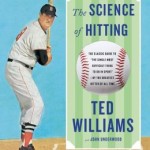
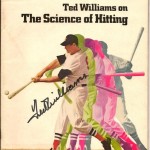
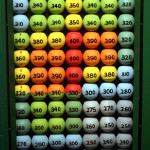
When a pitched ball approached the area of home plate that coincided with the coordinates determining the flight pattern of Ted’s bat, the poetic beauty of rhythm and timing of his majestic swing reflected an incomparable synergy that resounded with an impact of a solid communication. 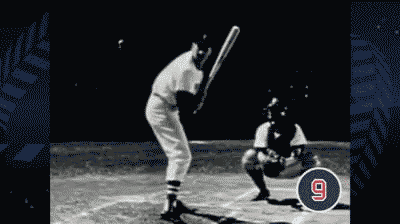 Bat united with ball for a brief moment to echo a glorified exuberance that resonated throughout the ballpark to sustain an illustrious piece of bats-man-ship. From the beginning of “gathering” body momentum, to the point where hickory and leather ignited a hint of scorching scent, the culmination of which transpired to a distinctively magnificent follow-through, the subjugated projectile took flight most often on a trajectory close to 180degrees (and climbing). (To hit the ball in any other manner would be to miss-hit it, and therefore denigrate any true artistic and scientific confluence).
Bat united with ball for a brief moment to echo a glorified exuberance that resonated throughout the ballpark to sustain an illustrious piece of bats-man-ship. From the beginning of “gathering” body momentum, to the point where hickory and leather ignited a hint of scorching scent, the culmination of which transpired to a distinctively magnificent follow-through, the subjugated projectile took flight most often on a trajectory close to 180degrees (and climbing). (To hit the ball in any other manner would be to miss-hit it, and therefore denigrate any true artistic and scientific confluence).
Farewell Ted! But you’ll be long remembered by all appreciative aficionados of artistic display as well as those aspiring artists who might consider upgrading to your scientific level of thinking, to possibly attain a semblance of your immortal status.
Part 4: Who has become, and who can be, beneficiary to Ted’s Scientific – Artistry?
